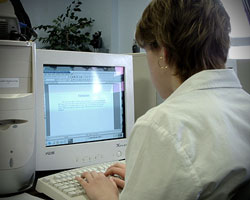 Working from home doesn’t have to mean sitting in front of a computer all day, but for many of us, that’s exactly what it means. I own a photography business, which someone might immediately picture as an action-packed sort of vocation. But the reality is, I’ll go and take pictures at an event or wedding, or take someone’s portrait, and then spend hours at the computer doing all my uploading and editing. Folks who work from home on a part time or full time basis doing even more computer-centric work, such as programming, will find themselves at the computer even more than I do.
Working from home doesn’t have to mean sitting in front of a computer all day, but for many of us, that’s exactly what it means. I own a photography business, which someone might immediately picture as an action-packed sort of vocation. But the reality is, I’ll go and take pictures at an event or wedding, or take someone’s portrait, and then spend hours at the computer doing all my uploading and editing. Folks who work from home on a part time or full time basis doing even more computer-centric work, such as programming, will find themselves at the computer even more than I do.
Even more than an office job, working from home in front of a computer can really enable us to be ‘computer potatoes’. We get a drink, a snack, and can easily spend hours engrossed in our work. Inherent in such long periods of inactivity is the risk of deep vein thrombosis (DVT) and pulmonary embolism. A DVT is a blood clot that forms, often in the legs. It can cause pain and discomfort, and if the clot breaks off and travels through the heart and into the lungs, it can cause a pulmonary embolism, a potentially life-threatening condition.
Besides long periods of sitting or laying, other risk factors for DVT and pulmonary embolism are obesity, dehydration, smoking, and high blood pressure. Obesity and dehydration are both fairly common risk factors to people who do a lot of computer work; it’s very easy to snack too much and move too little, and to forget to drink the requisite eight glasses of water a day. On top of that, drinking coffee or other caffeinated beverages contributes even more to potential dehydration.
Symptoms of a DVT can include pain and swelling in the affected area (usually a leg, but not always), tenderness and/or redness near the affected area, fatigue in the limb, and a ‘warm’ feeling on the limb.
If a DVT morphs into a pulmonary embolism, you can experience things such as chest pain, faintness, shortness, of breath, deep coughing which may produce blood, rapid breathing and the feeling you cannot catch your breath, and heart palpitations. If you feel these symptoms, especially if you’ve recently experienced the symptoms of a DVT, it is a life-threatening emergency and you should call 911 or have someone take you to the emergency room immediately!
Luckily, there are lots of simple things we can do to reduce our risks of a DVT and possible pulmonary embolism. The easiest and most effective is to get some exercise. Regular aerobic exercise is important, but simply getting up and walking around for a couple minutes each hour will help a great deal to prevent these conditions. Another step is to stay hydrated. Use those walking breaks to get a drink of water! Also, minimize your caffeine consumption, which can only make you more dehydrated. DVT and pulmonary embolism are seen more in obese people, so try to keep off any extra weight. Also, quit smoking, and see your doctor regularly to ensure your blood pressure is not elevated.
I hope you’ll keep these considerations in mind – they are easy steps that make it easy to prevent these conditions.
Photo © Extra Ketchup @ Flickr
